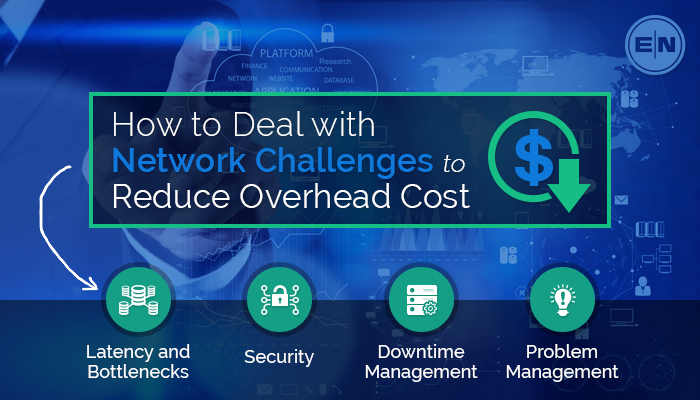How to Deal With Network Challenges to Reduce Overhead Cost

Network issues often suppress the continuation of profitable and effective Network management, and enterprises end up with overhead costs in dealing with the network issues. Check the post to understand on how to address network management issues and overhead costs related to them.

Network administrators face a number of ever-evolving challenges in the course of uptime and maintaining network to ensure business continuity. Companies are focusing on network expansion to meet future demands, with a trend toward utilizing IoT to increase agility and flexibility. The bandwidth of large networks require a smart strategy to optimize network performance and reliably support hundreds of mission-critical devices. These considerations often overlap with additional challenges relating to the cost of IT operations. It’s imperative that organizations identify and address the problems that have the most impact on growth and efficiency.
Latency and Bottlenecks
The evolution of virtualization has been driving network modernization and transforming data centers. Most IT operations can now be conducted over the cloud, enabling enterprises to achieve consolidation and facilitate collaboration through unified communication.
This consolidated system requires optimized network bandwidth to facilitate the successful proliferation of media files, immense amounts of data generated through IoT devices and large programs. Otherwise, networks can suffer from latency issues that can slow down data transfers and applications. Similarly, data bottlenecks caused by poor network architecture or slow-switch ports that don’t match the server speed can lead to traffic congestion for the server.
Prioritizing bandwidth utilization and a watchful, proactive approach to underperforming devices and network traffic is key to eliminating latency and bottlenecks.
It may also be helpful to remove unused protocols, such as IPV6, IPX Network Client, NetBios, LLMNR and PGM. These inactive protocols can often consume bandwidth unnecessarily, contributing to network congestion and poor network performance.
Routers and switches that use COPS, the common open-policy service, can allow QoS policy to run from the server. Enabling QoS over routers can enhance data streaming by prioritizing data packets through pre-defined policies and conditions. Once you have set priorities, you can prioritize the traffic by distinct services, including applications, web browsing, interfaces and devices with IP and MAC addresses. This will enable network administrators to divide the bandwidth based on the most critical applications available.
Security
The biggest threat to any enterprise’s data is cyber attacks. “Internal attacks are one of the biggest threats facing your data and systems,” says Cortney Thompson, CTO of Green House Data. Many attacks go unnoticed and unreported, with financial impacts from thousands to millions of dollars worth of loss. According to Forbes, the costs of cybercrime is expected to reach $2 trillion by 2019. Kaspersky reported large businesses could incur from £330,00 up to 1.2 million because of a cyberattack.
In most cases, the common vulnerable points in the network are BYOD devices, such as laptops and USB drives, as well as wireless points and emails. BYOD devices are vulnerable by shadow IT, allowing hackers to exploit weak spots through DoS attacks, email worms, rootkits, session hacking and root access, spear phishing and SQL injection to gain access to the most critical and privileged systems.
Combat these security deficiencies by hiring a team of cyber security experts who can define the proper security policies and take over responsibilities related to security patches, updates and monitoring. Look for expertise in network support baseline assessment and the proactive monitoring of logs and events across applications and devices. The team also needs to make sure peers and colleagues are educated on how to recognize and avoid phishing attempts and emails with suspicious attachments. While this is certainly a necessary expense, it’s important to consider the higher costs of managing an in-house security team versus outsourcing to a security agency.
Downtime Management
A recent Avaya survey found that network outages could cost a company an average of £54,750 per year. The common consequences of network downtime result in disruption of project continuity, loss of productivity and supply chain disruption. Generally, companies experience network downtime as a result of human errors, misconfiguration, routing problems, failure to upgrade and power outages.
The approach you need to take to minimize the impact of network outages is twofold. The first step is 24/7 network monitoring that not only looks out for current failures but proactively identifies specific devices or nodes that are at risk of failure in the near future. Second is the need to automate alerts regarding high CPU and bandwidth utilization as well as malicious activity across the network to prevent downtime and costly breaches. As with the security team, it may be prudent to outsource these tasks to save both money and time.
Problem Management
When companies conduct business across the globe and access data and applications via the cloud, a centralized management system is essential to effectively monitor each and every node and interface. It’s also important to be able to remotely fix problems as soon as they arrive to mitigate disruptions.
The challenge comes in selecting the most appropriate tools that can cost-effectively deal with security and bandwidth optimization challenges and drive a positive return on investment. Limited budgets, knowledge and resources are some of the biggest obstacles to network modernization necessary for sustaining today’s growing IoT needs. The high costs associated with managing outdated network infrastructure have resulted in companies having to embrace new networking trends, including a highly optimized network to ensure a smooth flow of information.
To resolve these issues, look for an outsourced, scalable managed network solution. This option can save on overhead costs by eliminating the need to buy multiple management tools as well as the costs of an in-house team.
Implementing the best tools and services is crucial to optimizing network performance and security while keeping costs low. An outsourced enterprise networking management service can help your organization maximize ROI and minimize TCO.
Takeaway
ExterNetworks believes best practices which intuitively pinpoint apparent glitches in the enterprise network. Network assessment, continuous bandwidth management and optimization can address critical network problems and performance. Additionally, network engineers can strive to monitor vast networks from different regions of the world for 100% uptime from a centralized management to address network issues before they can impact the whole network performance.
to Contact Us





